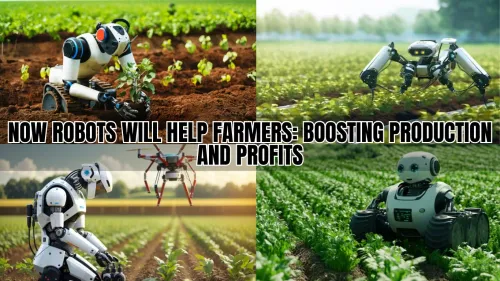Now Robots Will Help Farmers: Boosting Production and Profits

0 Views
Updated On:
Robots are revolutionizing farming by improving efficiency, reducing labor, and increasing crop production, making agriculture more profitable and sustainable.

Key Highlights
- Robots increase farming efficiency and reduce labor costs.
- They improve crop quality and yield.
- Robots perform tasks like soil sampling, sowing, weeding, and harvesting.
- The use of robots ensures precise pesticide and herbicide application.
- While expensive, they offer long-term benefits in productivity and profits.
The future of farming is here, with robots now stepping in to handle tasks traditionally done by people. From soil sampling to harvesting, advanced technology in agriculture is helping boost crop production and efficiency. Not only do these robots save time and labor, but they also make farming safer and more precise. Let’s explore how robots are transforming agriculture, what tasks they can perform, and the benefits they bring.
Also Read: Government Offers 75% Subsidy to Farmers for Growing Hybrid Vegetables in Bihar
Robots Taking Over Important Farming Tasks
In many countries, robots are already being used for various farming activities. These robots are especially helpful in areas that are difficult or unsafe for humans to reach. Here’s a look at some specific farming tasks where robots are making a difference:
- SmartCore Robot for Soil Sampling: For farmers wanting to test their soil, the SmartCore robot can automatically take soil samples. This helps farmers understand soil health without manual labor.
- Seed Sowing Robots: Robots can now help in sowing seeds. The Indian Agricultural Research Institute has developed a robot that sows seeds efficiently, saving both time and effort.
- Evo Robot for Weeding: Weeding is a time-consuming task, but the Evo robot handles it quickly by removing weeds without harming the main crop.
- TED Robot for Pruning Grapes: The TED robot is specially designed for grape vineyards, where it helps prune and sort grapes, ensuring quality produce.
- Tree Rover for Planting Trees: This unique robot, called the Tree Rover, can transplant trees from one location to another without damaging them, supporting conservation and planting efforts.
- Octanion Robot for Harvesting: The Octanion robot is designed for crop harvesting, particularly for picking strawberries. It’s fast, efficient, and gentle on delicate crops.
- Swagbot for Poultry Care: In addition to crop farming, robots are helping in animal husbandry. Swagbot, a robot developed for poultry farms, monitors chickens and keeps count of them, ensuring their safety.
Benefits of Using Robots in Farming
Robots offer numerous benefits for farmers, including:
- Faster Harvesting: Robots complete harvesting tasks quickly, reducing the time compared to manual labor.
- Precision Work: Robots allow precise application of pesticides and weed killers, reducing the risk of accidents and crop damage.
- Efficient Weeding: Robots are selective in removing weeds, saving crops from unnecessary harm.
- Cost Savings: Robots can help reduce labor costs and save time, making farming more profitable.
- Better Production: With robotic assistance, farmers can achieve higher-quality production, boosting their income.
Challenges with Robot Farming
While robots bring many advantages, they can be expensive, and not all farmers can afford them. However, for those who can, robots can greatly improve the quality and quantity of production.
As technology progresses, the use of robots in farming will likely become more common and accessible, promising a future of efficient, productive, and safe farming.
Also Read: Domestic Tractor Sales Rise in October 2024: 1,44,675 Units Sold with 22.37% Growth
CMV360 Says
Robots are transforming agriculture by improving efficiency, safety, and production quality. Although costly, they help reduce labor and increase yields, making farming more profitable and sustainable. As technology becomes more accessible, robotic farming tools are expected to play a key role in the future of global agriculture, benefiting both farmers and consumers.
